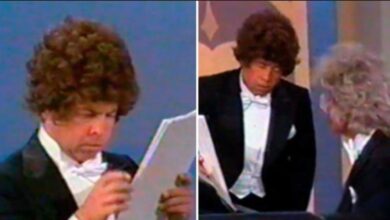The Traveling Wilburys’ “End of the Line” Proves Supergroup Synergy Could Still Spark Pop Magic in 1988
The first notes of “End of the Line,” released as a single in early 1989 but recorded in mid-1988 for the Wilburys’ surprise smash Vol. 1, felt like a warm hand clasped across decades of rock history. Built on a loping railroad shuffle and a mantra-like chorus promising that “everything’s gonna be all right,” the song instantly resonated with listeners hungry for optimism amid late-eighties pop excess. It climbed to number two on Billboard’s Mainstream Rock chart, cracked the Hot 100, and secured heavy rotation on MTV, proof that seasoned legends could still dominate airwaves alongside synth-soaked newcomers.
To appreciate why the track hit so hard, one must remember who was aboard this particular musical locomotive. The Traveling Wilburys were an almost mythic convergence of talent: George Harrison, Bob Dylan, Tom Petty, Jeff Lynne, and Roy Orbison—each a titan with distinct sonic fingerprints. Harrison brought wry spirituality, Dylan an unmatched lyrical gravitas, Petty his southern drawl and road-dog heart, Lynne a studio wizard’s knack for stacked harmonies, and Orbison the operatic quiver that once defined early-sixties drama. Together they embodied rock’s past, present, and possible future in a single room.
Legend insists the song’s genesis was as serendipitous as its breezy vibe suggests. Harrison had booked time at Dave Stewart’s Los Angeles home studio merely to cut a B-side, inviting “a few mates” to help. Once Dylan arrived with a half-finished verse scrawled on hotel stationery and Petty ambled in carrying only an acoustic guitar, the playful jam morphed into something larger. Harrison, drawing on childhood memories of English train rides, proposed a lyric about life’s journey; Lynne, ever the arranger, stitched their melodic fragments into a circular progression that felt endless yet complete—apt symbolism for five careers in perpetual motion.
The recording session, produced jointly by Harrison and Lynne, captured spontaneity without sacrificing polish. Drummer Jim Keltner laid down a near-skiffle beat, a subtly swung groove that let each Wilbury drop verses like passengers hopping aboard. Lynne’s 12-string Rickenbacker rang bright against Petty’s earthy strums, while Harrison’s slide guitar threaded wistful countermelodies between vocal lines. The chorus, sung in joyous unison, became the track’s beating heart; to thicken its gospel hug, Lynne layered up to a dozen harmony tracks, yet left just enough headroom for Orbison’s soaring ad-libs in the tag.
Critics who had anticipated an ego-bloated novelty project were pleasantly stunned. Rolling Stone praised the single’s “effortless camaraderie,” and British weeklies hailed it as “the gentlest victory lap in rock.” On U.S. radio, programmers placed it alongside contemporary hits from U2 and R.E.M., delighted to discover younger listeners requesting a song by artists their parents revered. The album soon went multi-platinum, and “End of the Line” became its unofficial anthem, earning a Grammy nomination and anchoring countless year-end best-of lists.
Beyond charts, the track shifted cultural conversation about aging rockers. Where mainstream narratives had framed veterans as nostalgia acts, the Wilburys demonstrated that collaboration could refresh legacy brands rather than embalm them. Their communal pseudonyms—Nelson, Lucky, Charlie T. Jr., Otis, and Lefty Wilbury—mocked celebrity while underscoring equality, subtly rebuking a star system that often pitted legends against one another. Fans sensed genuine friendship in the laughter laced through the outro, and that warmth helped bridge generational divides at a moment when hip-hop and glam metal vied for youth allegiance.
Professionally, “End of the Line” revitalized each member’s trajectory. Petty leveraged its success to launch his solo powerhouse Full Moon Fever with Lynne in the producer’s chair. Harrison, who had been semi-retired from touring, found renewed public appetite that paved the way for his 1991 Japanese concerts with Eric Clapton. Dylan, emerging from a mid-eighties critical slump, rode Wilbury goodwill into the well-received album Oh Mercy. Even Lynne, long typecast as ELO’s mastermind, became the era’s go-to producer for artists seeking vintage warmth with modern sheen.
Musically, the single’s blend of rootsy Americana and pop craftsmanship seeded ideas later embraced by alt-country outfits and Britpop architects alike. Its cheerful train-rhythm can be heard echoing in tracks by The Wallflowers and Gin Blossoms, while its multi-vocal hand-off anticipated collaborative forms in projects like Monsters of Folk. Producers studied Lynne’s dry drum sound paired with lush acoustic layering, a texture that would dominate George Michael’s Listen Without Prejudice and portions of Tom Petty’s subsequent catalogue.
Notable covers arrived swiftly: British folk icon Billy Bragg turned it into a protest sing-along during miners’ benefit concerts, replacing verses with political pleas; bluegrass legend Ricky Skaggs recast it in breakneck mandolin runs, underscoring its chord progression’s country roots. In 2017, country-rock supergroup The Highwomen performed it at the MusiCares tribute to Tom Petty, each member assuming a Wilbury role and earning a standing ovation that illustrated the song’s cross-genre reach.
Tragedy shadowed the single, too. Just weeks after final vocals were cut, Roy Orbison died of a heart attack, transforming the track—and especially its video—into an elegy. Directors substituted a gently rocking guitar in a spotlighted chair during Orbison’s verse, an image so poignant it left many viewers in tears and ensured the song would forever carry a note of bittersweet farewell. For Harrison, who had seen fellow Beatle John Lennon murdered eight years earlier, the moment added urgency to the Wilburys’ ethos of cherishing creative camaraderie while time allowed.
Over subsequent decades, “End of the Line” has refused to fade. It scores film montages from Lethal Weapon 3 to Wes Anderson’s The Darjeeling Limited, pops up in commercials selling everything from pickup trucks to retirement plans, and logs millions of Spotify streams annually. Classic-rock stations slot it between “Like a Rolling Stone” and “Free Fallin’,” signaling that the track stands shoulder-to-shoulder with each member’s most iconic work rather than beneath it.
In hindsight, the song also foreshadowed modern cross-pollination strategies. Long before DJ-driven pop mash-ups or superstar streaming duets, the Wilburys showed labels that audiences craved intersections of familiar voices when executed with sincerity. Its open-hearted lyric, promising safe arrival no matter how rough the ride, prefigured the communal uplift anthems of the 1990s—think “One Headlight” or “Good Riddance (Time of Your Life)”—that mixed folk honesty with radio-ready hooks.
Posthumous honors cement the track’s stature. When the Recording Academy gave George Harrison its Lifetime Achievement Award in 2015, “End of the Line” backed the tribute montage, while Dylan’s 2016 Nobel Prize retrospectives often included the song among career touchpoints demonstrating his collaborative generosity. The single’s gold certification, achieved decades after release through digital sales alone, underscores how new listeners continue to board its musical train.
Ultimately, “End of the Line” endures because it converts mortality—a subject lurking just below its jaunty surface—into reassurance rather than despair. Five legends, aware of the miles behind them, gather not to mourn time’s passage but to celebrate the ride and beckon fellow travelers with a grin. That spirit makes the track more than a historical curiosity; it remains a living reminder that creative chemistry, respect among peers, and a simple major-key strum can still yield timeless joy. In uniting individual brilliance under a shared banner, the Traveling Wilburys proved that the journey matters as much as the destination—and that, as their chorus promises, everything really is going to be all right at the end of the line.





